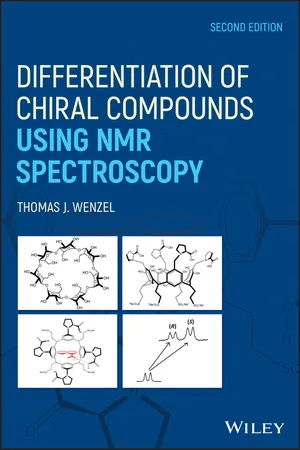
- English
- ePUB (mobile friendly)
- Available on iOS & Android
Differentiation of Chiral Compounds Using NMR Spectroscopy
About this book
An updated guide to the most current information available for determining how to use NMR spectroscopy to differentiate chiral compounds
Differentiation of Chiral Compounds Using NMR Spectroscopy offers a thoroughly revised second edition to the essential volume that puts the focus on the chiral systems that are commercially available and have been widely vetted for use in NMR spectroscopy. The text covers a broad range of reagents that make it possible to determine the enantiomeric purity and assign the absolute configuration of many classes of compounds.
Comprehensive in scope, the text describes the chiral NMR differentiating agents as derivatizing agents, solvating agents, metal-based reagents and liquid crystals and gels, and explains the range and types of compounds for which they can be used for analysis. New to this edition are the most recent findings in the field as well as the development of advanced NMR measurement techniques that allow for the simplification of complex spectra resulting in more readily identified enantiodifferentiation. This important resource:
- Includes the most recent coverage of a large range of compounds that can be analyzed using chiral NMR reagents
- Explores the use of chiral NMR reagents and explains their relationship to the stereochemistry of the analyzed molecules
- Offers the essential information needed to help decide which method is the best NMR method to apply to a class or molecules
- Contains experimental strategies for using the reagents that are likely to improve the quality of the results
Differentiation of Chiral Compounds Using NMR Spectroscopy is a comprehensive guide designed for investigators planning to use NMR spectroscopy to determine enantiomeric purity or assign the absolute configuration of a compound.
Frequently asked questions
- Essential is ideal for learners and professionals who enjoy exploring a wide range of subjects. Access the Essential Library with 800,000+ trusted titles and best-sellers across business, personal growth, and the humanities. Includes unlimited reading time and Standard Read Aloud voice.
- Complete: Perfect for advanced learners and researchers needing full, unrestricted access. Unlock 1.4M+ books across hundreds of subjects, including academic and specialized titles. The Complete Plan also includes advanced features like Premium Read Aloud and Research Assistant.
Please note we cannot support devices running on iOS 13 and Android 7 or earlier. Learn more about using the app.
Information
1
INTRODUCTION
1.1. CHIRAL DERIVATIZING AGENTS
1.2. CHIRAL SOLVATING AGENTS
Table of contents
- COVER
- TABLE OF CONTENTS
- PREFACE
- 1 INTRODUCTION
- 2 Aryl‐CONTAINING CARBOXYLIC ACIDS
- 3 OTHER CARBOXYLIC ACID‐BASED REAGENTS
- 4 HYDROXYL‐ AND THIOL‐CONTAINING REAGENTS
- 5 AMINE‐BASED REAGENTS
- 6 MISCELLANEOUS CDAs, CSAs, AND OTHER METHODS OF CHIRAL ANALYSIS
- 7 REAGENTS INCORPORATING PHOSPHORUS, SELENIUM, BORON, AND SILICON ATOMS
- 8 MACROCYCLIC AND RECEPTOR COMPOUNDS AS CHIRAL NMR DIFFERENTIATING AGENTS
- 9 CHIRAL DIFFERENTIATION WITH METAL‐BASED REAGENTS
- 10 CHIRAL NMR DIFFERENTIATION USING ORDERED SYSTEMS
- 11 CLOSING COMMENTS AND FUTURE PROSPECTS
- REFERENCES
- INDEX
- END USER LICENSE AGREEMENT